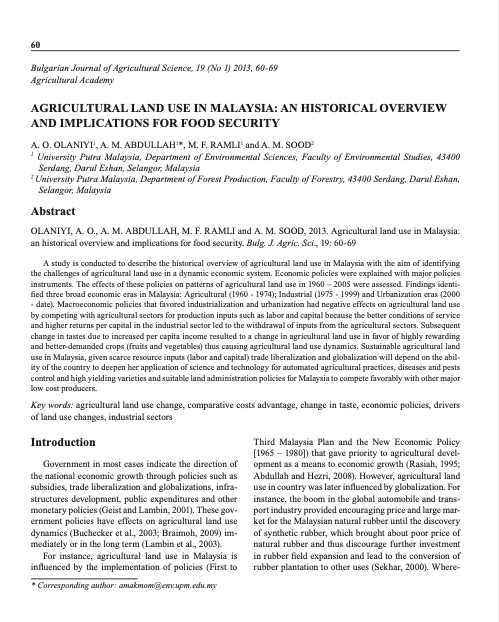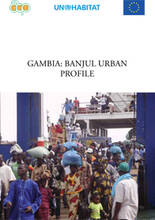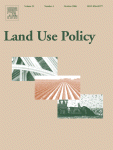Land privatization in urban Mongolia: an observation
The land privatization process in Mongolia mainly concerns residential land. The process is considered to perform slowly. The deadline for free allocation of residential land was extended from 2005 to 2013. Still, the number of families that have acquired private landownership during that period is low. This paper aims to take a closer look at the operational process in Ulaanbaatar. The paper finds that, when citizens apply, in a majority of cases the legal deadline to be granted a land-ownership right is actually met.
Kabul : Urban Land in Crisis
Urban Development - Urban Housing Public Sector Management and Reform Housing and Human Habitats Urban Development - Municipal Housing and Land Transport Economics Policy and Planning Communities and Human Settlements Public Sector Development Transport
Agricultural Land Use in Malaysia: An Historical Overview and Implications for Food Security
A study is conducted to describe the historical overview of agricultural land use in Malaysia with the aim of identifying the challenges of agricultural land use in a dynamic economic system. Economic policies were explained with major policies instruments. The effects of these policies on patterns of agricultural land use in 1960–2005 were assessed. Findings identified three broad economic eras in Malaysia: Agricultural (1960-1974); Industrial (1975-1999) and Urbanization eras (2000-date).
Planning Our City
Cities as we know them today are already dramatically changing. Our living environments are reshaping the way we live.
This new ‘urban age’ presents
a unique opportunity for us to remake and reinvent our cities. How well we plan and design our living environments will matter.
Designing our city looks at how Singapore is planned for long-term sustainability, encouraging us to think about how we can shape it and new ideas that can transform our future.
Spatio-temporal Dynamic Simulation of Urban Land Use in Karst Areas Based on CLUE-S Model: A case Study of Dahua Yao Nationality Autonomous County in Guangxi Zhuang Autonomous Region
This article uses TM images in 1999 and 2006 in Dahua County, selects the driving factors having great impact on urban land use change, and conducts data processing using GIS software. It then uses CLUE-S model to simulate land use change pattern in 2006, and uses land use map in 2006 to test the simulation results. The results show that the simulation achieves good effect, indicating that we can use CLUE-S model to simulate the future urban land use change in karst areas, to provide scientific decision-making support for sustainable development of land use.
image Gambia: Banjul Urban Profile
The Banjul Urban Profiling consists of an accelerated, action-oriented assessment of urban conditions, focusing on priority needs, capacity gaps, and existing institutional responses at local and national levels. The purpose of the study is to develop urban poverty reduction policies at local, national, and regional levels, through an assessment of needs and response mechanisms, and as a contribution to the wider-ranging implementation of the Millennium Development Goals.
Dispossession through land titling: Legal loopholes and shadow procedures to urbanized forestlands in the Yucatán Peninsula
Under certain circumstances, land titling, property regime changes, and land‐use conversions yield substantial profits. Yet few people possess the wealth, knowledge, and networks to benefit from these procedures. In the Yucatán Peninsula, a region recently targeted as a prominent investment location by the Mexican national government (mainly with the “Tren Maya” megaproject) and the private capital, forestlands collectively owned as ejidos by Mayan peasants are on the trend to complete privatization.
The Brazilian agrarian issue requires solution in the XXI century
Equity in informal land delivery: Insights from Enugu, Nigeria
Mounting exclusionary forces have made the task of achieving equity in urban land delivery more elusive than it has ever been. Statistics show that, in practice, most land for urban development (especially that occupied by the poor) is supplied outside state regulatory frameworks and there is overwhelming evidence of the importance of secure access to land and housing to the livelihood strategies of poor urban households.
Vertical cities as a solution for land scarcity: the tallest public housing development in Singapore
Singapore, whose land area is approximately 660km2, is one of the most densely populated cities in the world. In the 2001 Concept Plan, the Urban Redevelopment Authority estimated that Singapore would need 800000 more homes or 6400 ha of land to cater to a projected population of 5.5 million. Considering other competing demands for land resources, the 2001 Concept Plan has suggested constructing taller buildings. Thus, in August 2001, the Housing and Development Board initiated the development of a new 50-storeys public housing design.
As crenças, os nomes e as terras: dinâmicas identitárias de famílias na periferia de Maputo
Este texto apresenta algumas ideias relacionadas com os processos de (re)construção das identidades familiares, suscitadas no decorrer de uma investigação sobre estratégias de sobrevivência e reprodução social de famílias da periferia de Maputo. Introduzindo o texto com uma caracterização geral das estratégias mencionadas, de modo a fundamentar a importância da compreensão da dimensão identitária na sua análise, a autora analisa alguns dos processos simbólicos através dos quais se reconstroem e se perpetuam as identidades familiares no universo de estudo.










